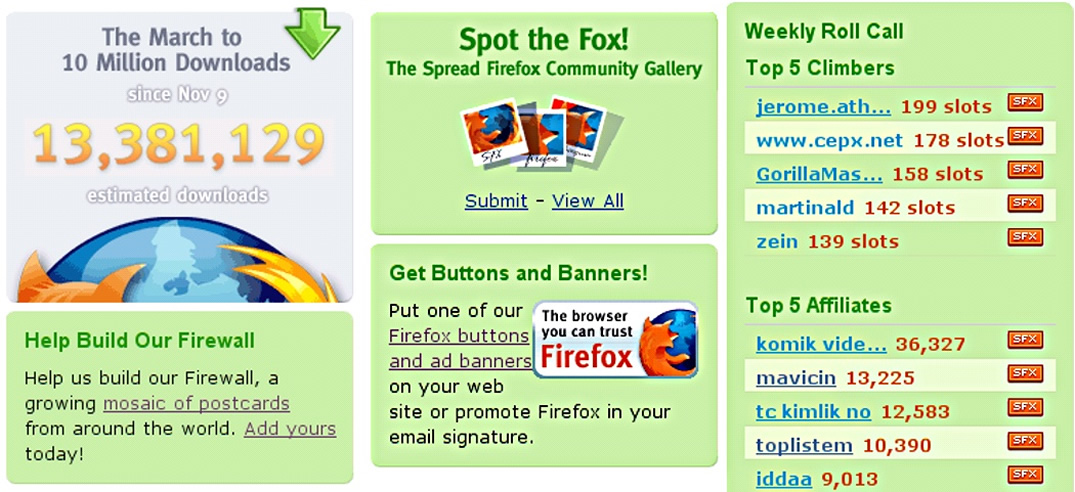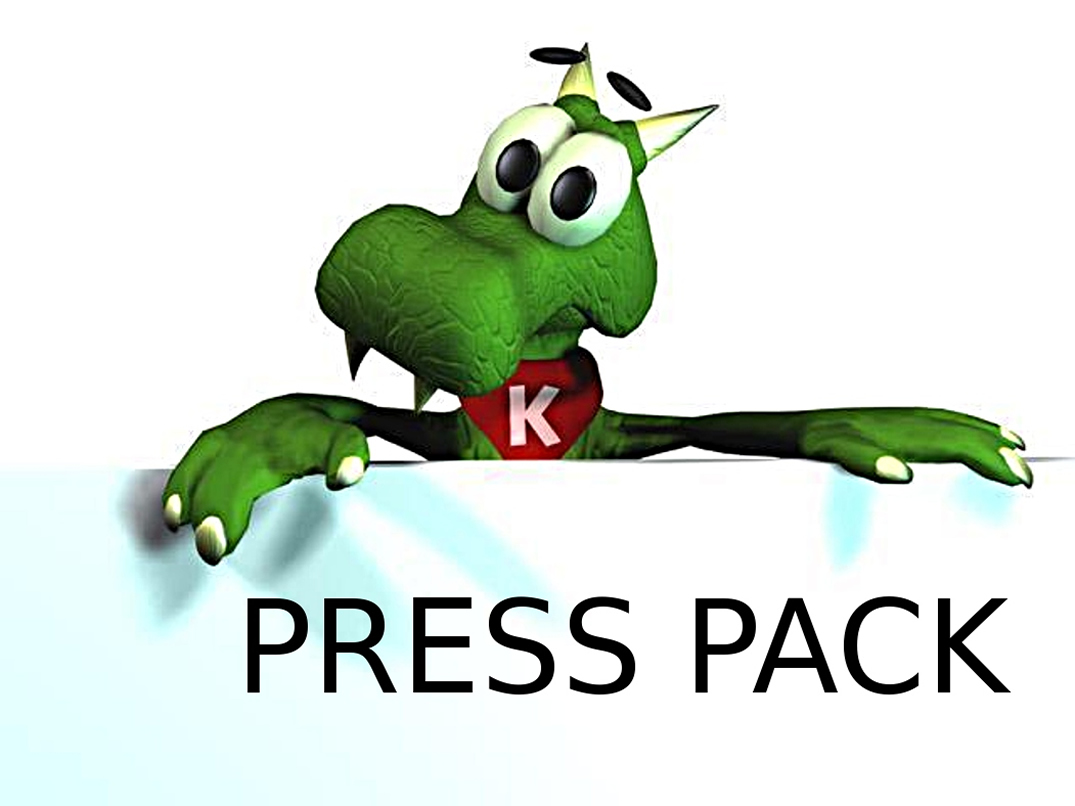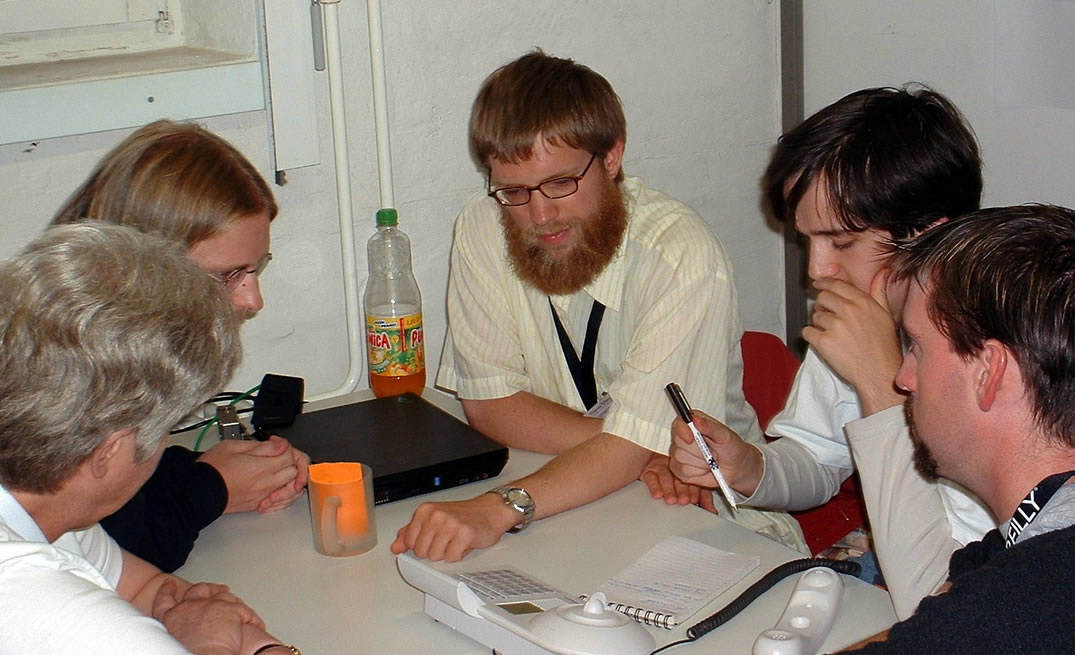It is a common assumption that companies who distribute free software will promote it, leaving the community to concentrate on the meat of the project itself (including code, documentation, graphics, and so on). But this is untrue; companies generally devote few resources and little expertise, leaving communities to fend for themselves in the big scary world of media and marketing.
Thankfully, all is not lost. Projects such as Mozilla Firefox, KDE and GNOME are fighting back with increasingly sophisticated promotion teams. In the past year we’ve seen massive fund raising initiatives, ever increasing community press coverage and a blossoming free software media market. If you’re in an under-promoted project, or you’re in a position to help, then this article is for you.
Community or marketplace?
Most free software projects operate in non-profit communities whose products are commercially distributed in the marketplace by third-party companies. This relationship has always benefited both parties, with most work done by one party benefiting the other. But this isn’t the case with marketing, where in general neither the communities nor their commercial distributors promote the products directly.
From the distributors’ point of view, this isn’t useful. They’re in the business of differentiating themselves from the GNU/Linux-based competition, and most free software projects will be used, without significant modifications, by all of their competitors. Instead they focus on promoting the value that they add to the projects’ products, and to a lesser extent the major features that make the project stand out from Microsoft Windows and Apple MacOS. So community projects do get promoted, but only indirectly.
In general neither communities nor their commercial distributors promote the products directly
For communities, a lack of people, resources and expertise tend to mean that promotion work is neglected. Time spent developing a watertight marketing strategy tends to be spent instead fixing bugs and implementing features, which is a reasonable compromise. The problem, then, is whether or not communities can effectively promote themselves in the marketplace. Even if your project attracts a few people with the requisite skills and you have the finances to print materials, attend trade shows and pay for advertisements, there is a wider problem: is your project commercially comprehensible? Will a company or public body be attracted to your community because of your adherence to free software principles, and will they be interested in learning about how they can interface with your volunteers? These hurdles aren’t insurmountable, and as the case studies I will examine will show, there is plenty that a community can do.
The spread of Firefox
Enter the fox. With relatively little company backing, a product from a major free software community achieved one of the most remarkable marketing successes of the year. The community headquarters, Spread Firefox, gained over 50,000 volunteers in a little under four months, and generated 13 million downloads in only 45 days. There won’t be many people in the IT industry this year who won’t have heard of Mozilla Firefox.
Spread Firefox gained over 50,000 volunteers in a little under four months, and generated 13 million downloads in only 45 days
The community’s technique was based on word of mouth, far more persuasive than any advertising campaign. From the early days of Phoenix and Firebird (Firefox’s previous incarnations), enthusiastic users were already telling their friends and family to try the web browser out. These users naturally developed shared beliefs about the benefits of using Firefox, and values relating to free software and open standards, which provided the basis for a rare commodity in the free software world: a genuine community of users. But it was still just an undeveloped basis, when in reality they had been a loosely connected fan club.
The first change came with an overhaul of the Mozilla web site: The homepage for each product presented a simple, coherent frame that fans could adopt. The frames were ideologically congruent with the fans, meaning that the fans passionately agreed with the spirit of the project presented by the frames, and the frames presented a short list of features that were popular with the fans (focusing on tabs, pop-up blocking and security). As fans began to consolidate around this shared message, a nascent community of marketers developed.
In September 2004, five enthusiasts announced Spread Firefox (sfx for short), a hub around which volunteers could gather to discuss and promote their favourite product. Sfx introduced three new techniques: targets, incentives and tools. From their first target of one million downloads in ten days, they expanded to other download figures, as well as raising funds for a full page advert in the New York Times.
To spur volunteers on, they cleverly presented simple incentives like web referral points (for each click on an advert), a regularly updated volunteer spotlight and plenty of community tub-thumping. Finally, they provided volunteers with consistent branding by way of advertising buttons for web sites, email signatures, leaflets, posters and literature. Armed with these tools, volunteers were able to spread the word more quickly and consistently than in any previous free software community effort.

Sfx matured with time, creating a wide range of positions for the most keen volunteers involving programming, writing materials, acting as a press contact, designing adverts, handling CDs, attending events and posing as college reps. Some teams worked on specific target markets such as colleges and home desktop users, tailoring materials to suit their audience.
They cleverly presented simple incentives and tools and were able to spread the word more quickly and consistently than in any previous free software community effort
The most spectacular success was the New York Times advert. The team set out to raise US$50,000 to finance a full page advert, and provided an incentive by offering every donor a space in the advert for their name. By the time the advert was in print they had raised over US$250,000 from 10,000 people, with the overflow going to the Mozilla Foundation.
The Firefox community is a clear example of how a simple frame, which is good for volunteers and the press, combined with some clever marketing techniques can propel a good free software product from obscurity to fame.
Can KDE and GNOME follow the fox?
Of course Firefox isn’t the only free software community working on its marketing strategy. Most of the major projects have been promoted to some extent, be it with a one-off stall at a trade show or OpenOffice.org’s impressive forty page strategic marketing plan. So why have they not been as successful, and how can they improve? To answer these questions I will look at KDE and GNOME, the leading free desktop environments, both of which have some marketing activity, and both of which rely largely on their commercial distributors for promotion beyond the reaches of their respective communities.
Products like KDE and GNOME face several major hurdles: for most computer users they require a migration to a completely new operating system like GNU/Linux or FreeBSD, whereas Firefox can be installed on every major consumer operating system; second, even where users can try them out (on Live CDs, for example), users are presented with a bewildering array of new features requiring a lot of time and interest to digest; and third, where users come into contact with them, the products are bundled with the distributor’s own offerings, usually re-branded and slightly modified, meaning that the individual, original products aren’t the main subject of promotion. Given these problems, it’s apparent that the Firefox community’s word of mouth campaign, based on a simple frame and a product that can be tested and promoted with ease, isn’t appropriate for all free software projects.
KDE and GNOME face further problems particular to their projects. Marketing is usually a matter of differentiating yourself from your competitors, so in their case you would expect them to regard each other as competition to be beaten. But the projects share code in libraries and standards, they share ideas and regularly inspire each other, and they even share some volunteers. Furthermore, many of their most exciting future features including DBUS, HAL and Cairo are being developed through freedesktop.org, a hub for developing shared, interoperable desktop technologies. They even benefit indirectly from each others’ releases, as each improvement makes the GNU/Linux system—which they are packaged as a part of—more attractive. As with many free software projects, they have to emphasise strength through cooperation with competitors.
So what are KDE and GNOME doing at the moment? For the KDE community, promotion work over the past few years has largely focused on trade shows and their news portal, KDE.News. If there has been a marketing strategy so far, it has been the result of volunteers developing common practices rather than any concerted strategic thinking.
Regular contributors from different countries have grouped into national (e.g. KDE GB and KDE NL) or continental (e.g. KDE North America) teams, who attend trade shows to show off their work to geeks and businessmen, armed with a demonstration computer and, usually, some basic literature. Other community members, largely core code and documentation contributors, write for and edit the news web site, providing a regular flow of information on the project’s status and the occasional promotional article. These same volunteers tend to write press releases for major versions of the desktop environment, and occasionally informal announcements for other events.
If there has been a marketing strategy so far, it has been the result of volunteers developing common practices rather than any concerted strategic thinking
There aren’t many volunteers in the KDE community who devote themselves solely to promotion work, in contrast to Firefox. The Dutch team, KDE NL, has taken the lead in this regard providing a regular team of volunteers at every major event, and producing a range of promotional materials including published articles, entry-level documentation, leaflets and press releases. Other teams are working to catch up, but again volunteer time, resources and a lack of expertise are holding them back. The arrivals of a marketing student and some volunteers with press experience are changing this, with a strategic review of competitors and a comprehensive press pack in the works. But KDE remains a long way off from the sophistication of Spread Firefox.

A big success story for the KDE community was aKademy, its annual conference, held last year in Ludwigsburg, Germany. For the first time, the community had a dedicated press team of three volunteers working full time to promote the event and the project. I was a member of that team, fielding calls from journalists, setting up interviews, writing and sending out press releases, producing a press pack for the event and even writing our own original material for a variety of publications. The event received an unprecedented amount of coverage from the usual tech media and the local media, thanks to the speedy translations of the German member of the team. A small investment of money, for travel costs and the devotion of a week from the volunteers, reaped large rewards for the project.
If you’re part of a free software community, or if you’ve got some time to volunteer for this kind of work, the important thing is to think about promotion strategically

The situation in the GNOME community is similar. Though they haven’t enjoyed KDE’s rich tradition of promotion through articles and news items to the same extent, and their annual conference GUADEC (GNOME Users and Developers European Conference) has yet to be promoted on the same scale, they have attended trade shows and courted distributors since their inception. But in recent months a transformation has been taking place on their mailing lists and Wiki. Inspired by a talk at GUADEC, a dedicated team of volunteers have been working on a strategy, developing clearly identified targets (including subsets of users, developers and distributors), materials to reach them with and the beginnings of a set of frames, one for each target market. You can review their efforts on their Wiki.
The strategies that these two major free software communities are pursuing have met with some success. Not only in terms of winning over new users and developers, and by giving them some bases for evangelising. But also by persuading distributors to use their products and by giving them the raw materials for their own promotional work. However, because of the difficulty in demonstrating a full desktop environment, and consequently, in migrating people to it; because of the difficulty of developing clear frames with targets, tools and incentives; and because of the simple lack of volunteers, they haven’t come close to matching the success of the Firefox community.
Conclusion
So where can we go from here? Clearly few free software communities can expect to be as successful as Firefox, but we can still expect worthwhile results. If you’re part of a free software community, or if you’ve got some time to volunteer for this kind of work, the important thing is to think about promotion strategically.
Work out who the likely target markets are, and discuss what strategies you might employ to reach them. For each strategy, think about how much effort you will have to put in, and how far you will move them towards using your product and/or joining your community. Then look at what resources you have and employ them carefully, taking care to avoid wasted time and volunteer burnout (where somebody does too much work for too long). Easy jobs include writing press releases and sending them out, responding to press enquiries, and providing promotional materials like web site buttons and leaflets. If you have the time, attend the relevant trade shows, give presentations and write full articles yourself for trade publications.
There’s plenty of potential for guerrilla marketing in the free software world
Given that community projects aren’t selling their product directly, it is a good idea to focus on feature parity and the benefits of free software. Luckily all good free software projects have plenty of raw material that the marketplace will understand. Push freedom from abandonware, your open and transparent development process, freedom from spyware and endless license tracking. Promote sharing and the virtues of free software development methodologies. Demonstrate how free software is usually more secure, cheaper and has fewer bugs. Promote the best features of your product. If you can reduce all of that into a clear, simple set of frames for users, developers, the press and, most important of all, your future promotion volunteers, you’ll be on the road to success.
Free software communities also need to remember the immense power of volunteer recruitment. Marketing is like any other job on a free software project: you need somewhere to start, with immediate or quick feedback and satisfaction. So if you’re looking for volunteers, make sure your community has a well-presented, clear list of tasks and jobs so that people can easily participate. This way you will focus effort effectively without having to rope volunteers into jobs they dislike.
Marketing strategy checklist
- A simple, clear frame, including ideology and a feature list
- Well-described target markets
- Appropriate materials, targets and incentives for each market
- A press team with contacts and release writers
- A web site to attract volunteers with clear tasks and longer-term jobs
There’s plenty of potential for guerrilla marketing in the free software world. As people with expertise in media work, marketing and writing come to use free software, so the communities that produce their software stand to gain from their time and expertise. We don’t need to, and indeed cannot, rely on commercial distributors to effectively promote free software. The job is left to us, so let’s get out there and reclaim the media and marketplace for the community.